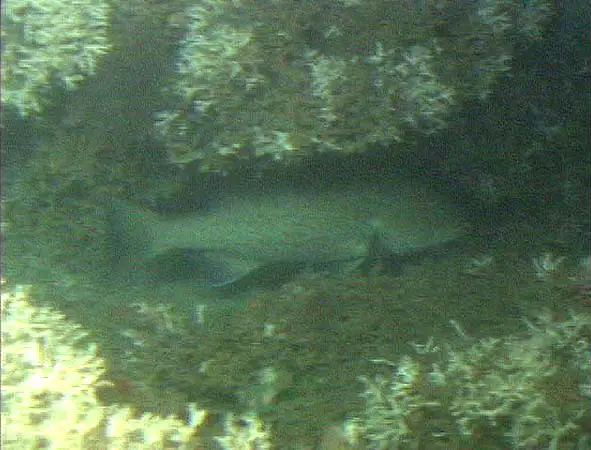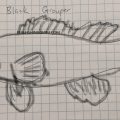The gag grouper is a marine ray-finned fish from the subfamily Epinephelinae and Serranidae. Aside from the scientific name Mycteroperca microlepis, they are known by many other names, for example, the gag, gag grouper, velvet rockfish, or charcoal belly.
Just like many other groupers, gag groupers are protogynous hermaphrodites. They are born females and change their sex to males when they mature. However, not all of them change their sex; some stay as adult females, which is not seen in many other groupers.
Gag groupers are very popular among people who catch fish and on restaurant menus.
What Do Gag Groupers Look Like?
The body of a gag grouper is robust and laterally compressed, oblong shaped. You will notice 11 spines and 16 to 18 soft rays on their dorsal fin, while the anal fin has 3 spines and 10-12 soft rays. The caudal fin is the longest of all the fins. They have a convex head.
A difference in coloration is noticeable between the male and female gag grouper. The adult females and their juveniles will show pale grey to greyish brown coloration. Darker blotches and wavy lines on the upper flanks and bank give them a marbled appearance. A fact about them is that they often camouflage themselves when resting. During camouflaging, they assume a pattern with 5 dark brown saddles separated by white bars along the base of the dorsal fin.
The adult males, on the other hand, usually have medium, grey-colored bodies. Their breast and belly are darker in color, usually a dark shade of grey or completely black. A reticulated pattern can be noticed under the dorsal fin, and the soft, rayed part of it also has a dark shade. The males have a color phase called “black-back,” where the body’s rear end and all soft rayed parts become black. Gag Groupers can grow up to 57 inches or 145 centimeters, but their most common length is only around 20 inches or 50 centimeters.
Where Do Gag Groupers Live?
Gag groupers usually stay in both brackish and marine waters. Sometimes they are found as solitary fish, but they are mostly in groups of 5 to 50. They are bottom feeders so they will likely be towards of bottom part of the ocean.
The most giant gag groupers are found in the western part of the Atlantic Ocean. A group also lives in the northern region, spread between the area near Bermuda and along the eastern coast of the United States from North Carolina south to the Yucatan Peninsula of Mexico. Gag groupers are the most widely available species of groupers found in the Gulf of Mexico.
The southern population exists in south Brazil, from Rio de Janeiro State to Santa Catarina State. There are also juveniles recorded as far north as Massachusetts. An accidental gag grouper (vagrant) was found in Cuba, but they are not widely distributed there.
Habitat preferences of gag groupers change as they mature. Juvenile gag groupers tend to stay in estuaries and beds of seagrass, but when they mature, they migrate farther offshore over rocky substrates at depths of 40 to 10 meters or 131 to 33 feet. After spawning, the females move towards shallower waters, with depths less than 30 meters or 98 ft. The males prefer to stay deeper, between depths of 50 to 90 meters (160 to 300 ft). However, sometimes adults are also found inshore over rock sea beds or seagrass beds.
Can You Eat Gag Groupers?
Yes, you can eat gag groupers. Gag groupers are among the three most popular groupers to eat among the 400+ species of groupers, alongside red and black groupers. Like the other two, gag grouper’s flesh has a very mild flavor, lying somewhere between sea bass and halibut. Additionally, it comes with a light, sweet taste and large, chunky flakes, like lobster or crab.
Groupers, like other fishes, also contain excellent amounts of protein, vitamins, and minerals. They can be a good source of nutrition. However, it being nutritious isn’t all that effective because eating groupers also has harmful effects.
You may already know that high levels of mercury are present inside the bodies of groupers, and gag groupers are also no exception to this rule. There are already tons of reports about ciguatera poisoning from eating gag groupers because of how popular they are.
You should likely reserve this fish only for special occasions. The NRDC recommends you limit eating this fish to three servings or less per month. There are tons of other fishes out there that are 100% safe, more flavorful, and equally nutritious, like largemouth bass and catfish.
Is Gag Grouper Fishing Allowed?
Fishing gag groupers are allowed, but it is highly regulated in the US. There are two stocks of gag groupers, the south Atlantic and the Gulf of Mexico. In both places, gag groupers were highly targeted by commercial and recreational fisheries, and juvenile fish were often caught as bycatch by fisheries that fished over seagrass beds. As a result, the species have become threatened by overfishing.
That’s why fishing regulations were imposed to reduce the fishing rate and conserve the species. The number of fishermen harvesting these fish has been limited, and commercial fishermen now have limited access to the permit of fishing gag groupers. Moreover, an annual catch limit and size limit has been imposed. Several gear requirements have been added to reduce bycatch. Moreover, commercial and recreational fishing seasons are closed from January through April, which is the spawning season.
The population is still significantly lower than the expected number, so a rebuilding plan is currently under development to recover the stock of gag groupers. While fishing for gag groupers are still allowed, it’s important to abide by all the restrictions imposed to preserve this species.













Pingback: Where do Groupers Spawn? | Reel Fishing Guru
Pingback: When Do Grouper Eat? | Reel Fishing Guru